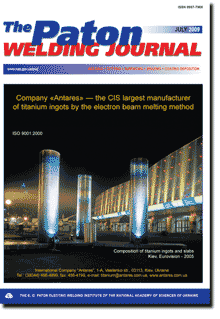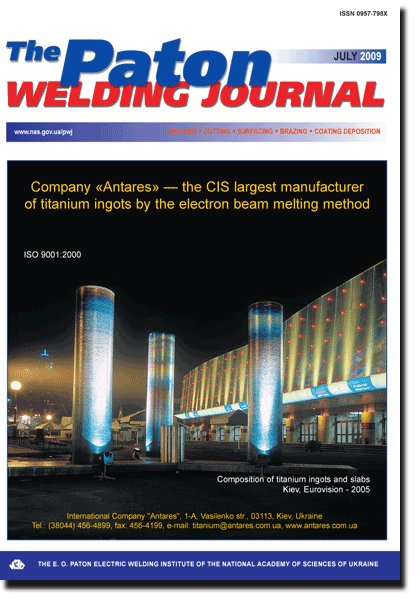| 2009 №07 (01) | 2009 №07 (03) |

TPWJ, 2009, #7, 12-17 pages
PECULIARITIES OF KINETICS OF DELAYED FRACTURE OF WELDED JOINTS OF HARDENING STEELS
Journal The Paton Welding Journal
Publisher International Association «Welding»
ISSN 0957-798X (print)
Issue № 7, 2009 (July)
Pages 12-17
Authors
V.Yu. SKULSKY
E.O. Paton Electric Welding Institute, NASU, Kiev, Ukraine
Abstract
The factors determining the rate of delayed fracture propagation at hydrogen embrittlement of welded joints of martensite steel at temperatures higher and lower than the revealed minimum of crack resistance (80-100 °C) and joints of bainite steel are considered. In addition to the known concepts it is shown that kinetics of delayed fracture can be determined by the character of distribution in the volume of metal of microplastic deformations, the propagation of which depends on the thermally-activated microstructural changes and rate of formation of local critical density of dislocations and hydrogen. In a general case the dependence of fracture duration on temperature is described using C-like curves.
Keywords: arc welding, hardening steels, welded joints, hardening, martensite, low-temperature decay, bainite, local deformation, delayed fracture, cold cracks
Received: ??
Published: 28.07.09
References
1. Shorshorov, M.Kh., Chernyshova, T.A., Rrasovsky, A.I. (1972) Weldability testing of metals. Moscow: Metallurgiya.
2. Hrivnak, I. (1984) Weldability of steels. Moscow: Mashinostroenie.
3. Karpenko, G.V., Kripyakevich, R.I. (1962) Hydrogen effect on steel properties. Moscow: Metallurgiya.
4. Makarov, E.L. (1977) Nature of fracture in cold crack for mation in high-strength hardenable steels during welding. In: Advanced technology of structural materials: Transact, of N.E. Baumann MVTU, 248, Issue 3.
5. Sarrak, V.I., Filippov, G.A. (1981) Effect of admixtures on brittleness of steel after hardening. Fiz.-Khimich. Mekhanika Materialov, 2, 96-101.
6. Kolachev, B.A. (1985) Hydrogen brittleness of metals. Moscow: Metallurgiya.
7. Makara, A.M., Mosendz, N.A. (1971) Welding of high-strength steels. Kiev: Tekhnika.
8. Suzuki, H. (1978) Cold cracking and its prevention in steel welding. IIW Doc. IX-1074-78.
9. Pidgaetsky, V.V. (1970) Pores, inclusions and cracks in welds. Kyiv: Tekhnika.
10. Terasaki, T., Hall, G.T., Parteger, R.I. (1991) Cooling time and prediction equation for estimating hydrogen diffusion in CTS test welds. Transact. ofJWS, 22(1), 53-56.
11. Skulsky, V.Yu. (2009) Thermokinetic peculiarities of forma tion of cold cracks in welded joints on hardening heat-resistant steels. The Paton Welding J., 3, 8-11.
12. Kasatkin, B.S., Brednev, V.I., Volkov, V.V. (1981) Procedure for determination of deformations in delayed fracture. Avtomatich. Svarka, 11, 1-7, 11.
13. Brednev, V.I., Kasatkin, B.S. (1988) Specific work of for mation of cold crack sites in welding of low-alloy high-strength steels. Ibid., 11, 3-8, 11.
14. Garofalo, F. (1968) Principles of creep and long-term strength. Moscow: Metallurgiya.
15. Honeycomb, R. (1972) Plastic deformation of metals. Moscow: Mir.
16. Kasatkin, O.G. (1994) Specifics of hydrogen embrittlement of high-strength steels in welding. Avtomatich. Svarka, 1, 3-7.
17. Kasatkin, B.S., Smiyan, O.D., Mikhajlov, V.E. et al. (1986) Hydrogen effect on susceptibility to crack formation in HAZ with stress raiser. Ibid., 11, 20-23.
18. Pokhodnya, I.K., Yavdoshchin, I.R., Paltsevich, A.P. et al. (2004) Arc welding metallurgy. Interaction of metal with gases. Kiev: Naukova Dumka.
19. Boniszewski, T., Watkinson, F., Baker, R.G. et al. (1965) Hydrogen embrittlement and heat-affected zone cracking in low-carbon alloy steels with acicular microstructures. British Welding J., 12(1), 20-42.
20. Kikuta, Y., Araki, T. (l980) Microscopic redistribution be haviors of hydrogen and fracture morphology of HAZ cold cracking in high-strength steel. IIW Doc. 11927-80.
21. Gulyaev, A.P. (1978) Metals science. Moscow: Metallurgy.
22. Kurdyumov, G.V., Utevsky, L.M., Entin, R.I. (1977) Transformations in iron and steel. Moscow: Nauka.
23. Lysak, L.I., Nikolin, B.I. (1975) Physical bases of heat treatment of steel. Kiev: Tekhnika.
24. Kehoe, M., Kelly, P.M. (1970) The role of carbon in the strength of ferrous materials. Scripta Metallurgica, 4(6), 473-467.
25. Novikov, V.M. (1986) Theory of heat treatment of metals. Moscow: Metallurgiya.
26. Fast, J.D. (1975) Interaction of metals with gases. Kinetics and reaction mechanism. Vol. 2. Moscow: Metallurgiya.
27. Choo, W.Y., Lee Young Jai (1982) Thermal analysis of trapped hydrogen in pure iron. Metal. Transact. A, 13(1), 135-140.
28. Moroz, L.S., Chechulin, B.B. (1967) Hydrogen brittleness of metals. Moscow: Metallurgiya.
29. Goudremont, E. (1951) Special steels. Vol. 1. Moscow: Metallurgizdat.
30. Zemzin, V.N., Shron, R.Z. (1978) Heat treatment and properties of welded joints. Leningrad: Mashinostroenie.
31. Macklintok, F., Argon, A. (1970) Deformation and fracture of materials. Moscow: Mir.
32. Makara, A.M. (1960) Study of cold crack nature in welding of hardening steels. Avtomatich. Svarka, 2, 9-33.
33. Kozlov, R.A. (1986) Welding of heat-resistant steels. Leningrad: Mashinostroenie.
Suggested Citation
V.Yu. SKULSKY (2009) PECULIARITIES OF KINETICS OF DELAYED FRACTURE OF WELDED JOINTS OF HARDENING STEELS. The Paton Welding J., 07, 12-17.The cost of subscription/purchase order journals or individual articles
| Journal/Currency | Annual Set | 1 issue printed |
1 issue |
one article |
| TPWJ/USD | 384 $ | 32 $ | 26 $ | 13 $ |
| TPWJ/EUR | 348 € | 29 € | 24 € | 12 € |
| TPWJ/UAH | 7200 UAH | 600 UAH | 600 UAH | 280 UAH |
| AS/UAH | 1800 UAH | 300 UAH | 300 UAH | 150 UAH |
| AS/USD | 192 $ | 32 $ | 26 $ | 13 $ |
| AS/EUR | 180 € | 30 € | 25 € | 12 € |
| SEM/UAH | 1200 UAH | 300 UAH | 300 UAH | 150 UAH |
| SEM/USD | 128 $ | 32 $ | 26 $ | 13 $ |
| SEM/EUR | 120 € | 30 € | 25 € | 12 € |
| TDNK/UAH | 1200 UAH | 300 UAH | 300 UAH | 150 UAH |
| TDNK/USD | 128 $ | 32 $ | 26 $ | 13 $ |
| TDNK/EUR | 120 € | 30 € | 25 € | 15 € |
AS = «Automatic Welding» - 6 issues per year;
TPWJ = «PATON WELDING JOURNAL» - 12 issues per year;
SEM = «Electrometallurgy Today» - 4 issues per year;
TDNK = «Technical Diagnostics and Non-Destructive Testing» - 4 issues per year.


